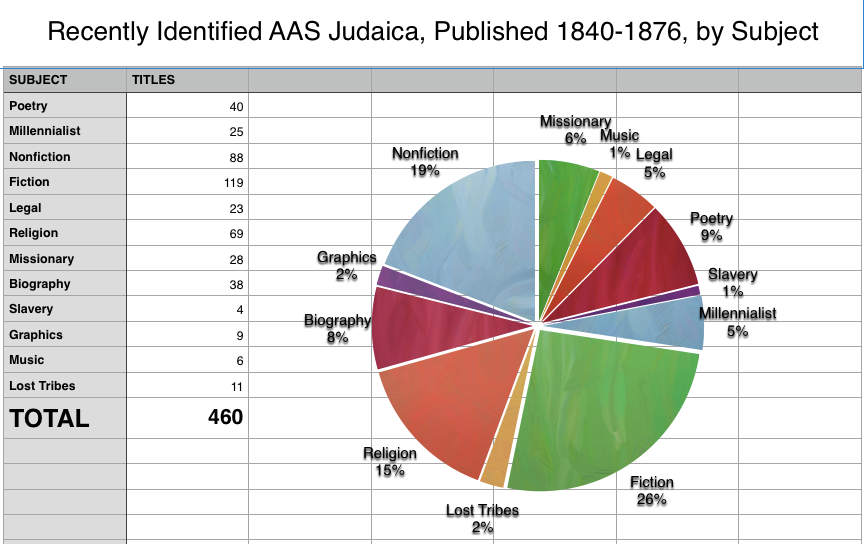Stay tuned throughout the summer for updates on Judaica at AAS from Claire Jones, an intern from Princeton University. Thanks to AAS chairman Sid Lapidus and the Princeton Internships in Civic Service program, Claire is working with Elizabeth Pope, curator of books, to identify, improve, and promote AAS’s Judaica collection.

Last month, I arrived at AAS for a ten-week internship in order to work on the Society’s Judaica collection with the enthusiasm of an undergraduate history major who has only a vague idea of what she’s getting herself into. My first few weeks were a bit of a whirlwind, settling in at AAS and beginning to wrap my head around the sheer volume of information housed here. Having the goal of collecting every printed work produced in North America before the U.S. centennial will do that to a collection; even though my area of focus for the summer—Judaica from 1841 to 1876—is relatively small by AAS standards, it was still a daunting prospect to just throw myself at the catalog and see what I could find.
Luckily, I’ve had a guide through all this mess. Yes, there’s my incredible supervisor, Elizabeth, whose understanding of the collection honestly still boggles my mind a bit, but the real hero of my first month at AAS has been Mr. Robert Singerman, without whose enormous bibliography, Judaica Americana, I would be so hopelessly lost. I spent my first two weeks checking all of his entries for the years 1841 to 1876—almost two thousand in total—against our online catalog. Sure, I got a lot of disheartening “Your search has returned no hits” results, but that search process meant reading through a list of quite literally every known work of American Judaica produced in my time period. I started to see patterns—names of people and institutions that kept coming up, popular topics for books and plays and pamphlets—and really got a feel for what mid-1800s American Judaica actually looks like. Most satisfying of all, though, was the finished product: a color-coded spreadsheet of a little over 450 titles, or around 25% of all American Judaica in my target years, that AAS now knows it has in its collection. Totally worth a few dead ends in the catalog.

Figuring out what exactly was in the AAS catalog had the added benefit of letting us know what kind of Judaica we were missing as well. One of the amazing things about AAS is that it’s always on the lookout for works it doesn’t already have: again, it’s the goal of the Society, to be as complete as possible within its scope. Despite this goal, though, there were a few significant gaps, the most prominent being works by Jewish thinkers or issued by Jewish institutions like synagogues or charity organizations. Elizabeth and I put together an acquisitions strategy for obtaining some of the missing titles,and also decided to make Jewish voices the focal point of our work on the collection this summer.
All of which brings me to my favorite part of my work here at AAS so far: picking out the most interesting-sounding works from my precious spreadsheet with the goal of finding and showcasing the highlights of the Judaica collection, both here and on the AAS website by the end of the summer. Actually getting a chance to interact with these nineteenth-century volumes is amazing, one of the best perks of working at a place like AAS, a place that is almost literally bursting at the seams with old books. As I probe the collection for whatever gems it can offer up, from the most important sermons and treatises to trashy novels and splashy pamphlets, we’ll be finding out a lot more about both our own collection and nineteenth-century Jewish life and culture itself. Whatever happens, we should emerge at the end of ten weeks with a beautiful cross-section of thirty-five years of Jewish life represented through AAS’s collections, bringing out an oft-forgotten part of the American story for our readers to discover and explore.

Great job! It certainly does look like a huge undertaking. Enjoy the summer.
Excellent work! Credit to Elizabeth for being such an incredible supervisor.